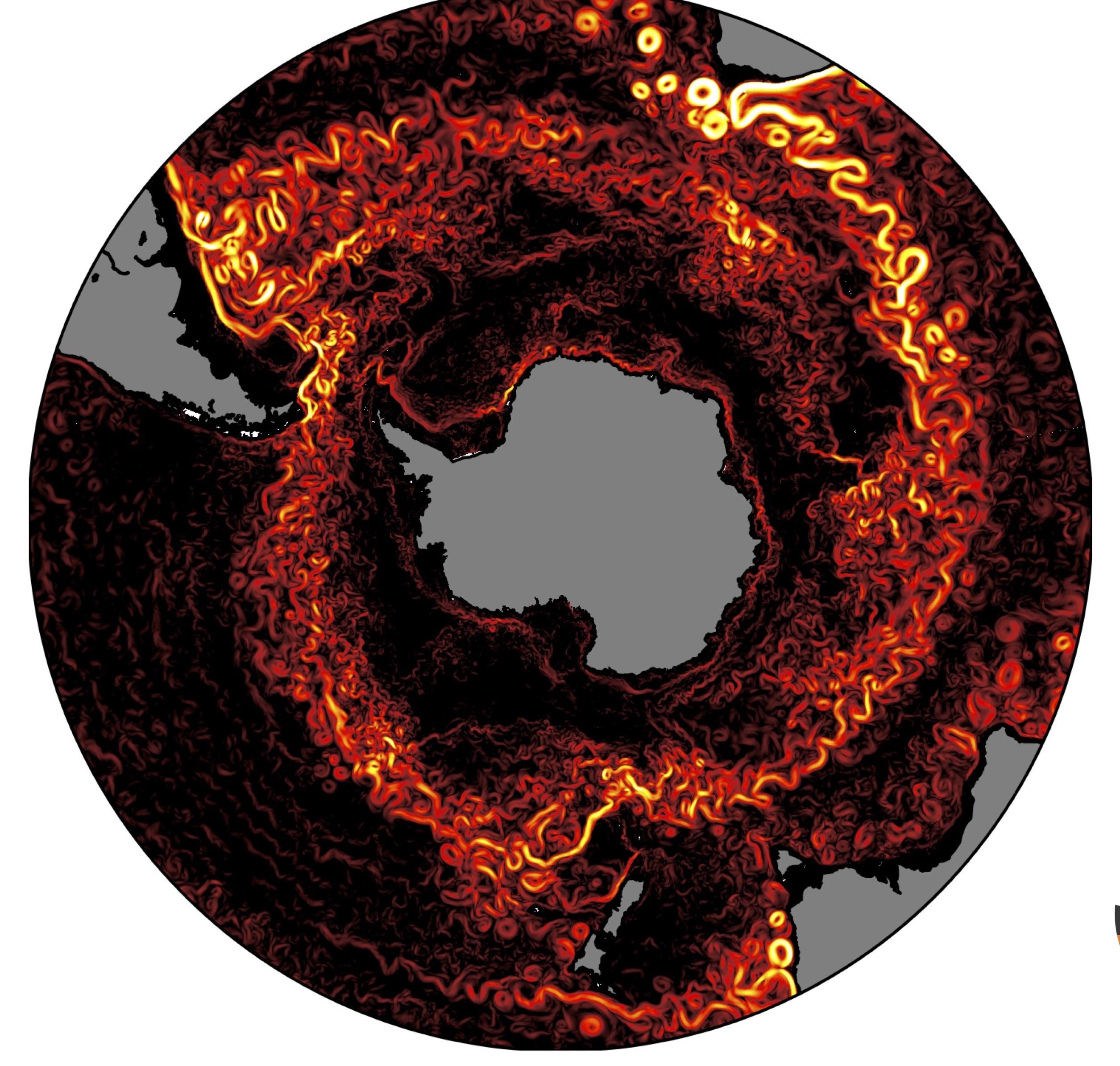Here we sample work that concerns elements of Southern Ocean mechanics and decadal predictability in the Atlantic.
Southern Ocean
I am part of a variety of collaborative efforts that support my research on Southern Ocean science, including SOCCOM, COSIMA, and DynOPO, each of which are discussed here. The coupled model CM2.6 is a critical tool used for some of these projects. CM2.6 is notable for simulating a rich mesoscale eddy field (see below image). This model has been the source for 40+ research papers as listed here, many of which concern the Southern Ocean.
Papers
- On the role of the Antarctic Slope Front on the occurrence of the Weddell Sea polynya: Lockwood et al (2021)
- Rapid mixing and exchange of deep-ocean waters in an abyssal boundary current: Naveira Garabato et al (2019)
- Lagrangian timescales of Southern Ocean upwelling in a hierarchy of model resolutions: Drake et al (2018)
- Localized rapid warming of West Antarctic Peninsula subsurface waters by remote winds: Spence et al (2017)
- Spiraling pathways of global deep waters to the surface of the Southern Ocean: Tamsitt et al (2017)
- CO2-induced ocean warming around the Antarctic ice sheet in an eddying global coupled model: Goddard et al (2017)
- Preconditioning of the Weddell Sea polynya by the ocean mesoscale and dense water overflows: Dufour et al (2017)
- Mechanisms of Southern Ocean heat uptake and transport in a global eddying coupled model: Morrison et al (2016)
- Role of mesoscale eddies in cross-frontal transport of heat and biogeochemical tracers in the Southern Ocean: Dufour et al (2015)
- An assessment of Antarctic Circumpolar Current and Southern Ocean Meridional Overturning Circulation sensitivity during 1958--2007 in a suite of inter-annual CORE-II simulations: Farneti et al (2015)
- Rapid subsurface warming and circulation changes of Antarctic coastal waters by poleward shifting winds Spence et al (2014)
- The role of mesoscale eddies in the rectification of the Southern Ocean response to changing forcing: Farneti et al (2010)

Questions
The Southern Ocean is home to the Antarctic Circumpolar Current (ACC),
whose depth integrated mass transport is the world's largest, and the
Southern Ocean meridional overturning circulation (SOMOC), which plays
a key role in the earth system through the ventilation/sequestration
of heat and carbon. These two circulations are tightly woven into the
fabric of Southern Ocean dynamics, with mechanisms affecting one also
affecting the other.
Closer to the Antarctic continent lives the Antarctic Slope Current,
which is a strong jet-like current flowing from east to west, largely
driven by coastal winds, the strong baroclinic front between the shelf
and open ocean, and tides. The ASF separates the generally warmer
waters off-shelf from colder coastal waters, with cross-shelf exchange
of warm waters of interest for sea level studies due to the potential
to melt ice shelves and to allow more land ice to enter the ocean.
Here are a few of the questions that interest me concerning the
Southern Ocean.
- What are the fundamental force balances active in the Southern Ocean, in particular relating to the role of bottom topography?
- What are the dynamics of zonal jets in the Southern Ocean, and how do these jets impact on the ventilation of carbon, heat, and nutrients?
- How will the depth integrated transport and meridional overturning transport be modified under changes to both wind and buoyancy forcing?
- How is the Southern Ocean, including along the continental shelf, impacted by large scale patterns such as ENSO and the Southern Annual Mode?
- What are the dynamical balances active within the Antarctic Slope Curent? How does the slope current interact with the ACC?
- What mechanics are responsible for transport of heat across the Antarctic continental shelf towards the base of ice shelves? How will the associated processes change under altered forcing?
Predictability
When I was a Princeton University post-doc (1993-1996), Kirk Bryan and
Eli Tziperman
(on sabbatical at GFDL during 1993-1994) pointed me to questions
related to decadal and multi-decadal variations of the North Atlantic
due to fluctuations of the Atlantic meridional overturning circulation
(AMOC). In the middle 1990s, these questions were largely theoretical
and model-based, given the lack of observational data. Nonetheless,
the model studies we conducted led to the first works on Atlantic
decadal predictability, thus providing the seeds for ongoing efforts
to capture any source of predictability available at these time
scales. As part of that work, I was led to collaborate with Tapio
Schneider, then a Princeton graduate student, on fundamental
questions about predictability. Tapio brought to these questions many
insights from information theory, with that work providing the seeds
for how we today measure predictability and predictable patterns.
I am presently not working on questions related to Atlantic decadal
predictability. However, GFDL has a very active group focused on
these questions.
- A conceptual framework for predictability studies: Schneider and Griffies (1999)
- A predictability study of simulated North Atlantic multidecadal variability: Griffies and Bryan (1997)
- Predictability of North Atlantic multidecadal variability: Griffies and Bryan (1997)
- A linear thermohaline oscillator driven by stochastic atmospheric forcing: Griffies and Tziperman (1995)
